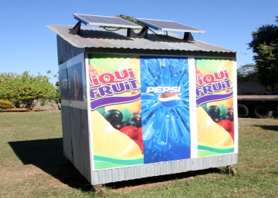Philipp Denzinger, GIZ Proklima
Off grid pilot locations: Swaziland, Seychelles, Jordan and Kenya
“Even in an off-grid system, if you’re not considering natural refrigerants, you’re not really being green at all”.
In developing countries, a refrigerator is often a first important purchase for a family moving into the middle class, while advantages of cooling technology are even more evident outside the home. Without cold storage, up to 40 percent of food production is lost due to spoilage. When small businesses have access to commercial refrigeration, the ability to store and transport food in cold storage cuts losses and enables a boost in productivity. But the rising global demand for refrigeration and air-conditioning (RAC) has an environmental impact. According to green-cooling-initiative.org, the RAC sector is currently responsible for 7 percent of global greenhouse gas emissions, about 3.7 gigatonnes in CO2 equivalent per year. That figure is projected to rise to more than 13 percent by 2030, at a time when the need to curb global warming means we have to be reducing emissions worldwide.
“Truly sustainable technology is what can make a difference as economies develop and the demand for refrigeration and air cooling grows”, says Philipp Denzinger. He is project manager for various Proklima green cooling projects implemented by GIZ and funded by the German Federal Ministry for Economic Cooperation and Development and the Ministry for the Environment’s International Climate Initiative.
One of these projects is the Green Cooling Initiative, which works to reduce emissions from the refrigeration and cooling sector by promoting natural refrigerants, maximising energy efficiency, and fostering a sustainable approach to private and commercial energy consumption.
“The aim is to establish a global Green Cooling Network to accelerate transfer of environmentally friendly technologies to and within developing countries”, says Denzinger. “We do this through helping with technology transfer, providing training, and giving policy advice. What we are trying to do is to bring people in this sector to work together”.

Natural refrigerants for greener cooling
GIZ Proklima focuses on both on- and off-grid systems to develop the most sustainable cooling possible. Denzinger sees contradictions in energy-efficient cooling systems that avoid burning fossil fuels but still use refrigerants with high global warming potential. Although on average two-thirds of greenhouse gas emissions produced by refrigeration and air-cooling come from burning fossil fuels for energy, one-third of the emissions come directly from the hydroclorofluorocarbons (HCFCs) and hydrofluorocarbons (HFCs) currently used as refrigerants in RAC equipment. “Even in an off-grid system,” says Denzinger, “if you’re not considering natural refrigerants, you’re not really being green at all”.
Refrigerant gases have a history of negative environmental impact. A landmark international agreement of the 1980s, the Montreal Protocol, phased out the manufacture of CFC gases used in refrigerants and other products. That was a notable international achievement to protect the Earth’s ozone layer. But CFCs were replaced by HCFCs and HFCs, introducing another environmental problem. HCFCs and HFCs are greenhouse gases with a global warming potential often a few thousand times higher than CO2. They leak into the atmosphere from refrigerators, air conditioners, and cooling systems during use and when products are discarded or dismantled.
HCFCs are already regulated and under phase-out, and in October 2016, the UN announced an amendment to the Montreal Protocol to phase down the production and consumption of HFCs. But Denzinger and GIZ Proklima have already been promoting a “leapfrogging” of that gradual phase-down. “Our aim is to skip the high and lower global-warming-potential HFCs and hydrofluoroolefins (HFOs), and go directly to natural refrigerants,” he says. Composed of ingredients like propane, isobutane, CO2, ammonia, water, and air, those natural refrigerants have negligible global warming potential. And unlike HFCs and HFOs, few are patented, so they can be produced economically in the country where they are to be used and don’t have to be transported long distances from the site of manufacture.
Off-grid pilots test green cooling in developing countries
GIZ Proklima’s off-grid pilot systems in Swaziland (SolarChill), Seychelles (GCI), Jordan (Solar Cooling) and Kenya (GCI), are examples of its approach. They’re demonstration projects that stretch for the greatest sustainability possible, like making ice and powering cold rooms with solar.

Denzinger points out that one hurdle to ultimate sustainability with solar photovoltaic systems is reliance on batteries that add cost to a project and have their own environmental impact. GIZ Proklima is investigating methods of solar cooling without batteries, like a project at a dairy in Jordan where researchers from the University of Berlin are looking at how to upscale parabolic solar cooling systems using natural refrigerants.
GIZ Proklima aims for long-term sustainability for developing countries with design that takes into account all the aspects of cooling system: the global warming potential of refrigerants, the sustainability of solar batteries, the capacities of technicians, and the availability of parts for repair. The work involves Proklima collaborating with local technicians, companies, and communities, as with a solar-powered cold store for fish it’s developing in Kenya. “We follow the ‘first do no harm’ approach”, says Denzinger. “It is not just about delivering cooling solutions and then leaving”.
–Valerie Schloredt, Writer and researcher




